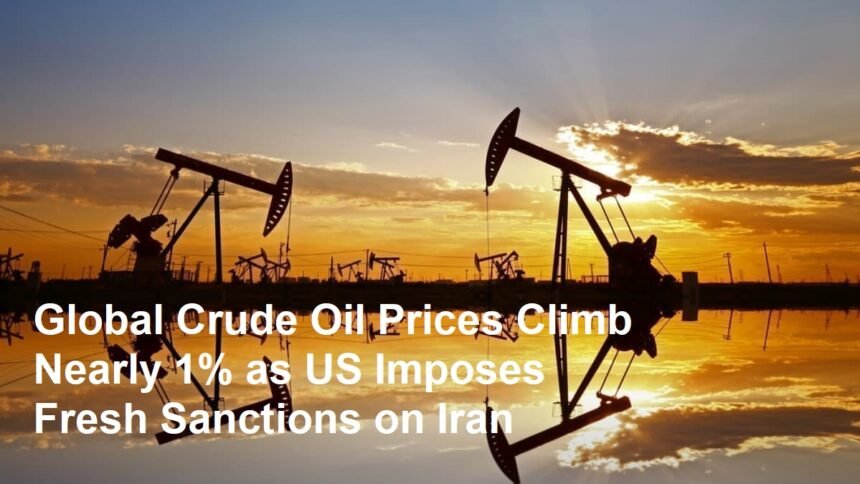World crude oil prices rose nearly 1% during trading on Wednesday, April 23, 2025, following the announcement of new U.S. sanctions targeting Iran’s energy sector. The sanctions, aimed at curtailing Tehran’s nuclear ambitions and regional influence, reignited supply concerns in already tight global markets. Brent crude futures edged up 0.9% to 94.50perbarrel,whileWestTexasIntermediate(WTI)climbed0.894.50perbarrel,whileWestTexasIntermediate(WTI)climbed0.891.20, marking the highest levels in three months. Analysts attributed the surge to fears of reduced Iranian oil exports and heightened geopolitical tensions in the Middle East.
US Tightens Sanctions: Targeting Iran’s Oil Revenue
The Biden administration unveiled sweeping measures to penalize foreign entities purchasing Iranian oil, closing loopholes that previously allowed limited exports to China and other Asian buyers. The sanctions also target Iran’s Central Bank and key shipping networks accused of facilitating “ghost armadas” to evade detection. U.S. National Security Advisor Jake Sullivan stated, “These actions underscore our commitment to preventing Iran from advancing its destabilizing activities.” The move comes amid stalled nuclear negotiations and Iran’s continued support for proxy groups in the region.
Market Jitters: Supply Constraints and Speculative Trading
Energy markets reacted swiftly, with traders pricing in a potential loss of 500,000 to 1 million barrels per day (bpd) of Iranian crude—a significant blow to global supply. Despite OPEC+ maintaining its current production quotas, the alliance’s limited spare capacity has amplified concerns. “The sanctions add pressure to an already fragile balance between demand and supply,” said Fatih Birol, Executive Director of the International Energy Agency (IEA). Speculative buying further fueled the rally, as hedge funds increased long positions in crude futures.
Iran’s Response: Defiance and Threats
Iranian officials condemned the sanctions as “economic warfare,” vowing to circumvent restrictions through alternative trade channels. Oil Minister Javad Owji claimed Tehran had “prepared contingency plans,” including discounted sales to non-Western allies and cryptocurrency transactions. However, analysts remain skeptical, noting that previous U.S. enforcement measures slashed Iran’s exports from 2.5 million bpd in 2018 to under 400,000 bpd by 2023. Meanwhile, Revolutionary Guard commanders hinted at potential retaliatory actions, such as disrupting maritime traffic in the Strait of Hormuz—a critical chokepoint for 20% of global oil shipments.
Broader Implications: Energy Security and Inflation Risks
The price hike has reignited fears of inflationary pressures, particularly in emerging economies reliant on imported oil. India, a major buyer of Iranian crude until 2023, faces renewed energy cost challenges, while China—Iran’s largest remaining customer—may seek concessions from Washington to protect its strategic reserves. In the U.S., rising crude prices threaten to dent President Biden’s efforts to stabilize gasoline costs ahead of the 2026 midterm elections.
OPEC+ in Focus: Calls for Production Adjustments
Pressure is mounting on OPEC+ to address the supply gap, but the group has signaled reluctance to revise output policies before its June meeting. Saudi Arabia, the de facto leader, emphasized adherence to “market stability,” while Russia faces constraints due to Western sanctions over Ukraine. RBC Capital Markets analyst Helima Croft noted, “Without Iranian barrels, OPEC+ may need to reconsider its strategy sooner than planned.”
Renewables and Shale: A Balancing Act
The crisis has intensified debates over energy transition timelines. While renewable energy adoption has accelerated, fossil fuels still account for 78% of global energy consumption. In the U.S., shale producers are cautiously ramping up drilling, but investor demands for fiscal discipline limit rapid output growth. “The world remains stuck between decarbonization goals and immediate energy needs,” said energy strategist Vandana Hari.
Global Diplomatic Ripples
The sanctions have drawn mixed reactions internationally. European allies, wary of secondary sanctions, pledged compliance but urged Washington to avoid further escalation. Conversely, Gulf states like Saudi Arabia and the UAE privately welcome reduced Iranian competition in oil markets. Meanwhile, Beijing criticized the measures as “unilateral coercion,” signaling potential friction in U.S.-China trade talks.
Looking Ahead: Volatility on the Horizon
As markets digest the sanctions’ long-term impact, volatility is expected to persist. Energy analysts warn that prolonged disruptions could push Brent above $100 per barrel by mid-2025, complicating central banks’ efforts to tame inflation. For now, all eyes remain on Iran’s next move—and whether diplomatic backchannels can avert a deeper crisis.
In conclusion, the U.S.-Iran showdown underscores the enduring link between geopolitics and energy markets. While the immediate price surge reflects speculative anxiety, the broader stakes—energy security, inflation, and global stability—will shape economic landscapes well into 2026.









